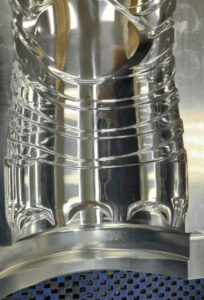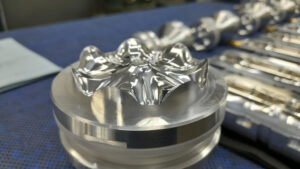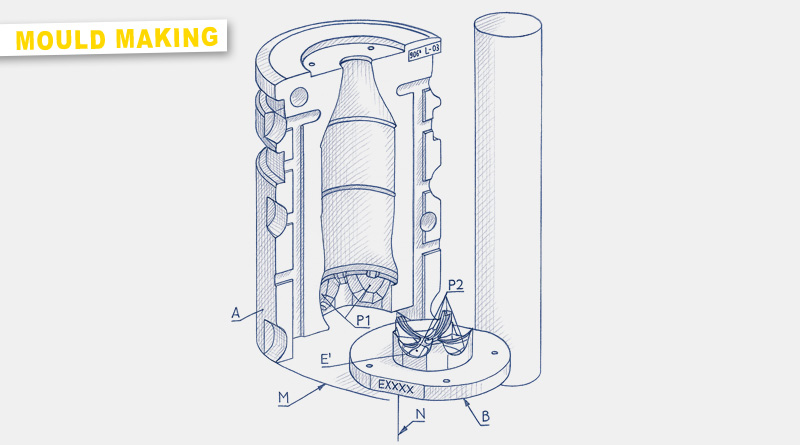Advancing mould engineering
Redefining blow mould design through precise kinematic integration and clever mechanics
Reducing blowing pressures alone is insufficient for today’s demanding PET bottle production. Moldintec introduces a three-dimensional mould partition line for the petaloid base, precisely synchronised with the machine’s mechanical motion. This holistic engineering approach is claimed to achieve reliable low-pressure bottle formation, to enhance mould performance, reduce moving mass, and to deliver superior product aesthetics.
In the dynamic and competitive world of PET bottle manufacturing, continuous innovation is essential for maintaining market leadership and sustainable growth. Moldintec, recently introduced KnetMold. This technology aims to redefine traditional stretch-blow moulding processes, particularly for PET bottles featuring petaloid bottoms used primarily in carbonated beverages.
Historically, the production of robust PET bottles has necessitated blow moulding operations at pressures around 25 bar or less. Moldintec has established itself as a known player in this field by successfully developing its ultra-low-pressure BaseMax moulds. These moulds reliably achieve petaloid base formation at pressures as low as 16 to 20 bar, even accommodating large containers up to 3 L. With KnetMold technology, Moldintec advances the mechanical engineering aspects of mould construction rather than merely focusing on blow pressure reduction.

Current mould construction methods often rely on simple planar or cylindrical partition lines. While effective, these traditional approaches present limitations, particularly in the precision and efficiency of air evacuation, cooling management, and overall mould durability, says Moldintec. Recognising these constraints, the company’s expert team implemented a unique three-dimensional partition line that aligns with the mould’s mechanical and kinetic interactions within the blowing machine.
The distinctive feature of KnetMold technology is this three-dimensional partition line, meticulously engineered by carefully studying the exact trajectories and mechanical movements of mould segments during the opening and closing cycles of the machine. This sophisticated approach is intended to ensure mould segments move synchronously without interference, facilitating optimal interaction between the mould and the preform throughout the blowing process. Consequently, the PET preform expands uniformly and accurately, closely replicating the intended bottle geometry, even at significantly reduced blowing pressures, achieving reliable performance below the critical threshold of 14 bar.
“Every petaloid base needs a unique 3D parting line that is linked with the blower kinematics. Our engineers must find the optimal curve that improves the air venting, the machining process, and the minimum mass as possible. At the beginning of the project all the analysis was made using the engineering software tools, but today they are training an AI agent to help them to optimise the curve design in a fraction of the time.” emphasises Alexis Martin, Principal Eng. at Moldintec’s Buenos Aires TechCenter. “Our approach strategically leverages advanced mechanical engineering principles, which deliver energy savings, reduced manufacturing costs of the moulds, moving mass of the base subassembly, and enhanced product quality.”

This mechanical solution helps to optimise the venting process. “KnetMold design strategy eliminates the previously necessary small perforations or complex 3D laser-machined pathways required to evacuate trapped air by directly integrating specifically engineered venting channels into the three-dimensional partition line,” comments Diego Taboada, Chief Operations Officer based at Moldintec’s Headquarters in Buenos Aires, “This evolution simplifies mould manufacturing, reduces production time, and minimises long-term maintenance needs, further boosting economic efficiency.”
Beyond air evacuation improvements, KnetMold technology enhances thermal management, says the company. By strategically distributing petaloid geometry between the lateral mould segments and the bottom insert, Moldintec has optimised cooling circuits to achieve more efficient heat removal. This precise thermal control ensures uniform and rapid cooling, substantially reducing internal stress variations and enhancing the bottle’s resistance to stress cracking – a crucial factor for maintaining the structural integrity of carbonated beverage containers.
Nevertheless, innovations inherently come with new technical challenges. The intricate geometry associated with the three-dimensional partition line makes some areas of the mould thinner than conventional designs. Moldintec proactively addresses this concern by employing carefully calculated curvature radii and using specialised protective fixtures specifically developed for mould storage and handling outside production machines. These measures protect the integrity and durability of the moulds, underscoring Moldintec’s dedication to overcoming challenges through continuous innovation and technical know-how.
In addition to operational and mechanical advantages, KnetMold technology also improves the aesthetic quality of PET bottles. The innovative three-dimensional partition line creates smoother transitions and less visible seam lines, enhancing the finished product’s visual appeal and perceived value – an essential factor for brand positioning and consumer satisfaction.
Ongoing R&D to simplify mould mechanics
Latest developments also point to a potential simplification of the mechanical system. Moldintec is now considering eliminating the third movement – the vertical displacement of the base subassembly – since the mould can open even when the base remains stationary. The team is currently working on methods to separate the base insert and the bottle without losing alignment with the mould centre line. This could represent another step forward in reducing mechanical complexity, wear, and cycle time.
KnetMold technology is claimed to offer benefits such as decreased energy consumption, enhanced mechanical durability, and consistently high-quality output. To further validate its approach, Moldintec has applied for patent protection (patent pending) for the KnetMold technology. The company continues rigorous industrial validation programs, inviting potential collaborators and interested parties to engage directly with Moldintec’s technical experts.

